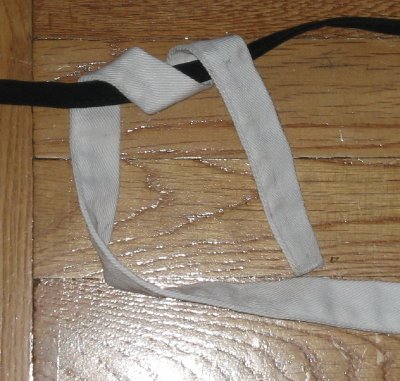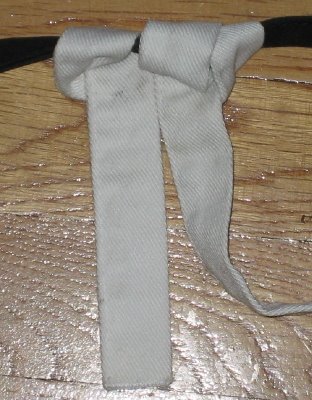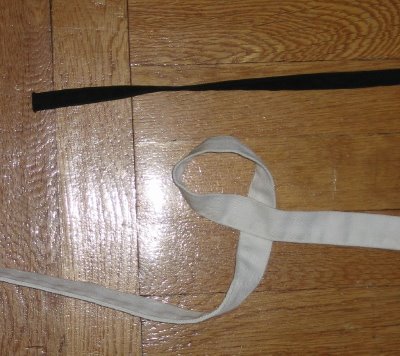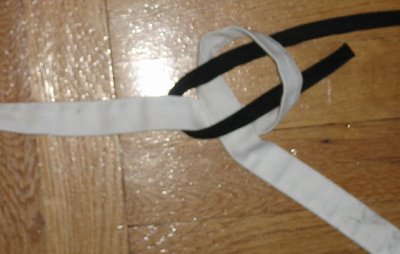The easiest and best way to for us tie the boat in its normal ligplaats is to simply tie the boat to itself.
Make sure the lines come off at as big an angle as possible (do not tie the boat to closest point on the wall). Note the lines can also go in, rather than out, if need be (it might need to be if there's only one object you can tie to). The line is tied to the boat's kicker with a little twist, repeated.
There are at least four knots you need to know for our everyday boat use: the hitch, the bowline, the clove hitch, and the tautline hitch. These really do come in handy in life. Just yesterday I used both these in one piece of string to tie a Victrola case shut for travel (yes, Bob, that's why they called it "portable"). On one end, the bowline made a loop. On the other end, the tautline hitch then can then make things nice and snug. The best part is that when I was tying things up to come back home, a guy said, "hey, that's a bowline!" He made my day.
The bowline knot (pronounced correctly as BOW-lin, I don't know why I mispronounce it in the video) makes a very secure loop in the line (like around a pole, for our docking needs). It is always easy to untie, even when wet and under pressure. That is one of its main benefits.
This is the most important knot to know. You can never go wrong with a bowline. Never. It makes a loop in rope. It will never come undone. It is always easy to undo. It might save your life. Maria can tell you all about that.

The only tricky part about making this knot is making sure this loop is in the right direction. This is the way I do it. And remember that the loop must come in the section of the line that is between what you're tying up and what you're tying up to. Then you feed through the end of line through this hole.


The way I do it means the end of the line comes up through the hole.



 Always look for this tidy figure-eight-like shape at the end. That's your confirmation you've done it correctly.
Always look for this tidy figure-eight-like shape at the end. That's your confirmation you've done it correctly. To undo a bowline, just push up on the stem, the part coming from whatever your tying up.
The clove hitch is a great and simple way to tie a line to a round object.
A description of the very simple concept of slip knots (easier to undo). Here you see a clove hitch slip knot. It's the most fun to undo.
The tautline hitch is adjustable after it is tied. Wow! How cool. It's good for anything you need to keep taut after tying, like a clothesline... or an unloading boat. It's great if you're loading or unloading a boat with lots of fat people.
The cool thing about this knot it that you can slide it back and forth and adjust the tension. It helps, when you tie this, to keep things tight as you go. You'll probably have to tighten it a bit when you're done.
Here I've tied around the pole and am now tying the not. You start by encircling the line in the direction toward what you are tying to.

You do that once, and twice.

Then come around on the side of the line (the line that came from what you're tying to) that logically keeps that line tight.

Do one more loop, again in the direction toward the knot and what you are trying to. It actually doesn't matter which direction you make this last encircling. Some people like the lines coming out in different directions. I'm partial to them coming out on the same side. I heard it's stronger. It may not be. But I do think it's prettier.



There should be three loops lined up neatly in row. And of course one line needs to remain straight. That's why you can adjust it by sliding back and forth.


If the line is long, you can alway double back the line at the length you want. Then just treat the double line as a single line for any of your knots.
One last thing: here's a very poorly tied boat!
 Not only is the boat drifting too far from the wall (because the other line was also tied like shit), but this knot is bullshit (malakies, you might even say). It's overly wrapped around the post. For no benefit. What a pain to undo. A simply clove hitch would do.
Not only is the boat drifting too far from the wall (because the other line was also tied like shit), but this knot is bullshit (malakies, you might even say). It's overly wrapped around the post. For no benefit. What a pain to undo. A simply clove hitch would do.Learn knots, please. It's important. You'll be happy you did. And I'll be happy to. And have some pride! You're a St. Nick Boat Captain.















